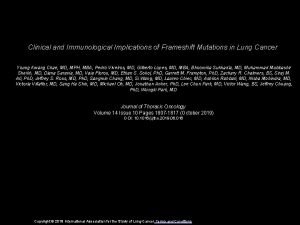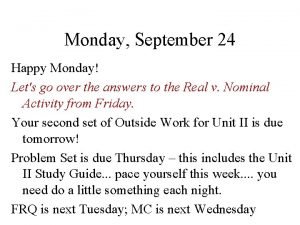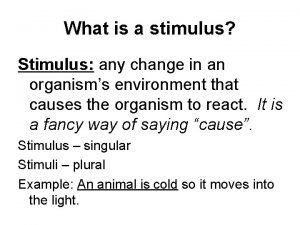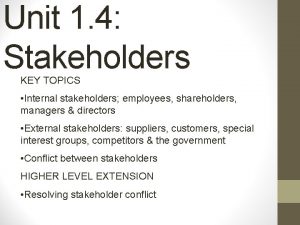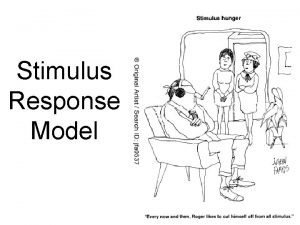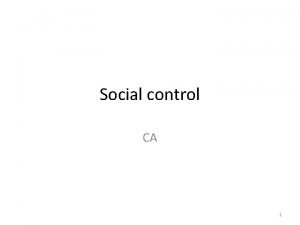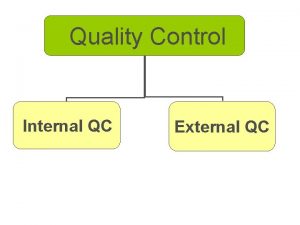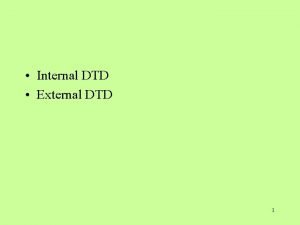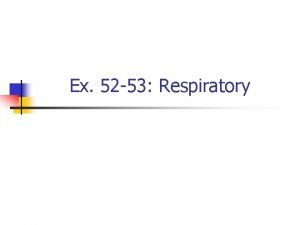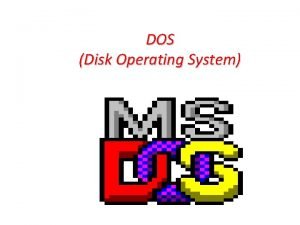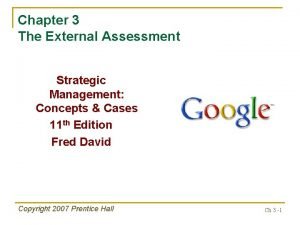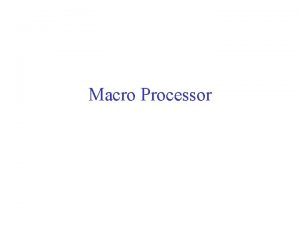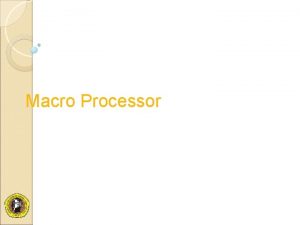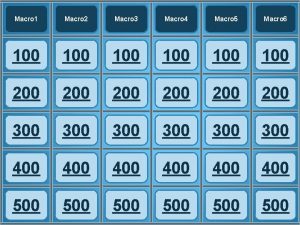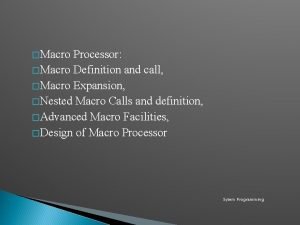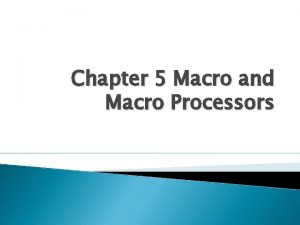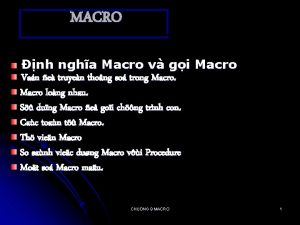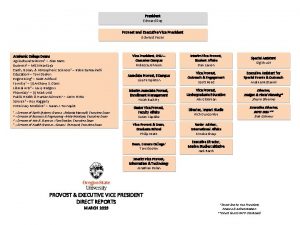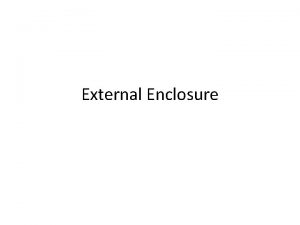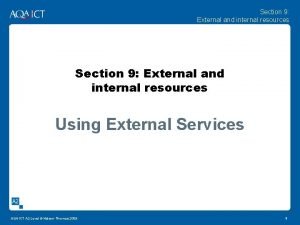Macro Edward Kwang President Internal and External Macro







































- Slides: 39

Macro Edward Kwang President

Internal and External Macro • Internal Macro is used to automate task inside Elliott • External Macro is used to communicate with other Windows application for automation • They are both keystroke based – any users can learn how to use it.

Demo of an Internal Macro • Print an Aging Report by Customer – Show “Detail” – Show Customer Owe More Than $100 That’s Past Due – Show the Open Item Only • Develop a Macro that always supplies the same parameters.

Designing an Internal Macro • Locate the field where you want to execute the macro. • Write down the keystrokes you want to automate on a piece of paper and simulate the process. • Go back to the original field, then click “Macro” tool bar button (look like a Gear). – – Choose “Internal” tab Click “New” button Enter the Macro name and click “OK” Go down to the 1 st line of [Script] section and start to enter the keystrokes.

Execute Macro inside Elliott • A predefined Internal Macro is only valid at the specific field of a screen. (Why? ) • Script Syntax: – “XYZ” = means type “XYZ” and hit “Enter” key. – {enter} = Enter Key – ; ; = Comments • Assign Hot Key

Demo {Wait} Syntax • What if you wish to stop at the middle of the script and prompt user for some value before proceeding? – For example, different aging date – Use {Wait}

Demo of Macro Documentation • Where do you find more information about Macro? – From the workstation where you install Elliott. Choose “Start” -> “Programs” -> “Elliott 7” -> “System Manager” (Require Acrobat Reader) – Browse to C: ELLIOTT 7DOCSM. PDF

Internal Macro Applications • Automate Repeating Keystrokes – Based on your operation procedure, certain fields will always be entered certain ways: – Run an report – Add a customer – Add an item – Data Entry

Demo Command Prompt Macro • Startup Elliott and go directly to A/R Aging Report by Customer Number – Choose “Detail” – Allow to {Wait} for Aging Date – Show Open Item Only – Default all other fields {enter} • Bring up the Print Option Screen – Send to Disk

Folder for Command Macro • Create a folder on your desktop to store the command prompt macro • Let’s name the folder “Month End” • Create a short cut in the folder by using right click • Enter the startup command as – m: elliott 7el 700 02 0401 0101 – Name the short cut as “Aging Report”

Command Macro Syntax • The first parameters determine which module – – – – – 01 = GL 02 = AR 03 = AP 04 = PR 05 = BB 06 = IM 07 = COP 08 = PO 09 = BOMP …etc.

Command Macro Syntax • 2 nd Parameter (0401) is for Menu Choice – 04 means the 4 th menu item • 01 = Maintenance • 02 = Inquiry • 03 = Processing • 04 = Reports • …etc. – 01 means the 1 st drop down item • 01 = Aging Reports • 02 = Commission Due Reports • …etc.

Command Macro Syntax • 3 rd Parameter (0101) is for menu choice – The first 01 means the first menu item “Print” – The 2 nd 01 means the first drop down menu item “By Customer Number”

Run Aging Report Automatically • Modify the “Aging Report” short cut and change the command as: m: elliott 7el 700 02 0401 0101 “D” ~ ~ {wait} ~ ~ “Y” ~ ~ ~ %d • “D” = Change the default “S” (Summary) to “D” (Detail) • ~ = Enter (same as {enter}, ~ is the abbrev. form) • {wait} = will wait for the aging date field • “Y” = Change the default value “Show Open Item Only” to “Y” • %d = Alt-d (% = Alt key) which means print to Disk in the Print Option window.

Command Macro Limitation • 256 Bytes Command Prompt Limit with Certain O/S – Can’t write complicate macro with 256 bytes • Use the file option if you need to run a complicated macro: – el 700 02 /f: aging. mac

Run Command Macro from a file • Create a Macro File “aging. mac” with notepad in elliott 7macro (the default directory) • Put the following content in this file 0401 0101 “D” ~ ~ {wait} ~ ~ “Y” ~ ~ ~ %d • Either one line or multiple lines will be fine. Save the file. • Change the startup command as: – EL 700 02 /F: AGING • The extension can be omitted if you use. MAC as extension. • The file path can be omitted if you store in the default Macro directory. • You can’t omit the module number in command prompt.

Command Macro Applications • Setup Procedure of Doing Routine Tasks – Month End Procedure – Daily Procedure • Bypass User Name and Password – Have one Elliott session open

External Macro • Leverage other Windows application to do the job • Unlike Internal Macro, External Macro is not field sensitive • External Macro is screen sensitive • As long as you know the keystroke for use an Window application, you can control it from Elliott • Information that send to the other window application must present on the current screen.

Demo Customer Welcome Letter • Bring up a customer record in customer change and Click on the Macro • In External Macro tab, highlight the “Customer Welcome Letter” (This is the default macro distribute with Elliott V 7) • It might not work depends on two factors: – Where you install Elliott (default assumption c: elliott 7) – What is the version of your O/S (default assume 95/98/me) • Verify the directory where Notepad is installed and what is setup in the default Macro. • Verify the Scripts where it bring up file “Welcome. txt”

Run Welcome Letter - Notepad • Run from the “ARCUSMNT” screen – Not field sensitive – It is screen sensitive – Assign Hot Key • Problem with Notepad – System Date – Font

Welcome Letter – MS Word • Use Welcome. txt as a basis and create Welcome. doc in your Elliott directory. – Date issue (Use Date Field in Word) – Change to proportional spacing font (Times New Roman) • Create a new External Macro • Browse to the directory you can find Microsoft Word: – c: program filesmicrosoft officeoffice 10 – This directory for Office XP. If you use a different version of MS Office, then it will be in a different directory. Therefore, this Macro is Office version dependent. You can not run this Macro with, say, Word 2000. • Choose winword. exe • Caption is important! Find out the name of your application that will always show up on the title bar (in this case “Microsoft Word”)

Capture Fields in Macro • Go to specific field – Click “Add Fields” on “Macro” popup menu – Accept the default value for field name, Row, Column and Length. Click OK – Repeat this until you capture all the fields you need.

Writing Scripts in Macro • Click on the “Script” Button on “Macro” popup menu. • Go to the first line of [Script] section and put down the following lines: %fo c: elliott 7welcome. doc{enter} {down 4} Attn: @@Contact@@{enter} @@Corresp-Name@@{enter} @@Address-1@@ @@Address-2@@{enter} @@City@@, @@State@@ @@Zip-Code@@{enter}

External Macro Scripts Syntax • Similar to Internal. Please reference SM. PDF in c: elliott 7doc for details. • %fo means Alt-F O (File Open) • At this moment the file dialog box should open and system is prompting for the file path and name. • c: elliott 7welcome. doc{enter} will supply the file path and name, plus an “enter” key for the default action which is “Open button”.

External Macro Scripts Syntax • {down 4} will bring the cursor down to the position where the name and address should be populated. • Attn: @@Contact@@{enter} will first put “Attn: “ on the line and system take the field name “Contact” and substitute its value and append it after “Attn: “. The system issue an {enter} key to advance to the next line.

External Macro Scripts Syntax • @@Corresp-Name@@{enter} will put the company name at the current position and issue an {enter} key. • @@Address-1@@ @@Address-2@@{enter} will combine Address-1 and Address-2 at the same line – The reason is in many cases Address-2 is blank and we do not want to display a blank Address-2 on a separate line. • @@City@@, @@State@@ @@Zip. Code@@{enter} will put the City, St Zip in the correct format.

Save the Macro • Exit Notepad and Answer “Yes” to save the file. • Click “Done” on the “Macro” popup menu to finish the Macro definition.

Test the Macro • Bring up customer record and click on “Macro” button. Highlight the Macro we just created and choose “Step”. • Check if there’s any error. If error found, cancel “Step” and fix the macro by using “Edit” -> “Script” • When all errors are cleared, choose to “Walk” which is a slow animation mode. • Once “Walk” is working. You can choose to “Run”. • Assign Hot Key in Properties if necessary.

Print Envelop Macro • Use the following scripts: %tee %e %d Attn: @@Contact@@{enter} @@Corresp-Name@@{enter} @@Address-1@@ @@Address-2@@{enter} @@City@@, @@State@@ @@Zip-Code@@{enter} @@Country@@ • %tee means Alt-T E E (Tool -> Letter and Mailing -> Envelop and Letter • %e for Envelop Tab • %d for putting cursor in “Delivery address” text box

Excel Customer List Macro • Create an Excel Spread Sheet with the following columns: – Company Name – Address 1 – Address 2 – City – State – Zip Code – Contact – Date • Save it as “Customer. xls” in c: elliott 7. • Use it for Mail Merge (Batch) at the end of a day.

Excel Customer List Macro • Use the following Scripts: %fo m: nsicustomer. xls{enter} ^{end} {home} {down} @@Corresp-Name@@{right} @@Address-1@@{right} @@Address-2@@{right} @@City@@{right} @@State@@{right} =TODAY(){right} • ^{end} means CTRL-End (Bring to the end of the spreadsheet) • {home} means the Home Key and will bring to the first cell of the current row • {down} will bring to the next cell to start entering data on a new row

Phone Dialer Macro • Call the customer phone number by using the modem that connect to your phone. • Many CRM software come with a dialer to perform this kind of function. • In Elliott, you can use Macro to achieve the same functionality by utilizing Windows default Phone Dialer.

Find out Where is Phone Dialer • Start -> Programs -> Accessories -> Communication -> Phone Dialer • Right Click on “Phone Dialer” and choose “Properties”. It will show the location of phone dialer: C: Program FilesWindows NTdialer. exe • Different version of Windows O/S maybe place dialer. exe in different directory. • Therefore, this Macro is O/S dependent

Dial a Phone from Sales Desk • Configure your Sales Desk to display phone number after entering customer number. • Phone Number is a display field so you need to figure out its position manually. • Find the first field that you can “Add Field”. • Use that field’s position to figure out the Phone Number position. • Verify if your position is correct by choosing “Step” when test the Macro.

Dial a Phone Scripts • Use the following Scripts for Sales Desk %pi @@Phone. No@@ %p {enter} • %pi means Alt-P I (Phone Dial) • %p to ensure the “Phone Number” is selected (Not the Internet) • Keep in mind this Macro will only work in Sales Desk. • If you wish to have “Dial a Phone” macro in Customer file maintenance, you need to develop another macro. – External Macro is screen dependent

Handling O/S and App Version • The Macro you developed might only work for certain O/S or Application Software (MS Office) – Due to the EXE is placed in different directory. • Standardize your O/S and Application version will help. • Create different Macro directory for different O/S or Application version. – Click “Setup Preference” button on Tool Bar – Choose “Misc” Tab – Change the default Macro directory • i. e. “{Default}Offxp. W 2 K”

Best Practice for Macro • Keep your Windows O/S & MS Office version consistent will help to share Macros. • Close External Application When Done. – Elliott External Macro can’t deal with the application program if it has been opened already. • Assign Hot Key consistently through out. – For example, if you pick Alt-D for dial a phone macro. Then use Alt-D for dial a phone macro in all screen. – Inconsistent hot key assignment will confuse users.

Conclusion • Anybody can write Macro in Elliott – You just need to know the Keystrokes for how to use Elliott or external Application. • Reference System Manager document for detail information – C: elliott 7docsm. pdf • Use your imagination.

Questions & Answers
 Kwang moo yi
Kwang moo yi Young kwang chae md
Young kwang chae md Chapter 7 reflections bns
Chapter 7 reflections bns Ducks unlimited checks
Ducks unlimited checks Accounting information system chapter 1
Accounting information system chapter 1 Econmovies episode 6 back to the future worksheet answers
Econmovies episode 6 back to the future worksheet answers Conditional macro expansion in system software
Conditional macro expansion in system software Negative hydrotropism
Negative hydrotropism Internal users of accounting information
Internal users of accounting information Internal and external stakeholders examples
Internal and external stakeholders examples Stimulus response feedback model
Stimulus response feedback model Social control in sociology
Social control in sociology Internal and external factors of nationalism
Internal and external factors of nationalism Reliability test in research
Reliability test in research Internal vs external qc
Internal vs external qc Quality control in blood banking pdf
Quality control in blood banking pdf Stakeholder internal and external
Stakeholder internal and external Transversus abdominis
Transversus abdominis Iso 14001 risk and opportunities examples
Iso 14001 risk and opportunities examples Interrupt priority register is bit addressable
Interrupt priority register is bit addressable External development
External development Internal and external parts of computer
Internal and external parts of computer Crescent type oil pump
Crescent type oil pump Internal and external dtd
Internal and external dtd External conflict
External conflict Internal vs external intercostal muscles
Internal vs external intercostal muscles Finishing line rpd
Finishing line rpd What is internal stimuli
What is internal stimuli Internal and external nares
Internal and external nares Dos disk operating system
Dos disk operating system Bad mouth betty
Bad mouth betty Two types of conflict
Two types of conflict What is semantic noise
What is semantic noise Classification of removable partial denture
Classification of removable partial denture External and internal character traits
External and internal character traits Internal memory and external memory
Internal memory and external memory External assessment in strategic management
External assessment in strategic management Forces of change
Forces of change Objective of business
Objective of business Internal and external barriers of communication
Internal and external barriers of communication

